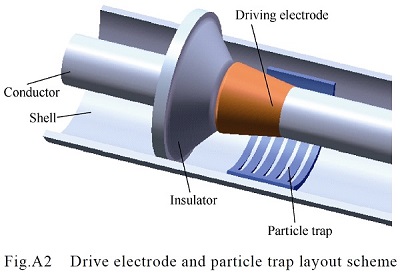| [1] 张连根, 路士杰, 李成榕, 等. GIS中线形和球形金属微粒的运动行为和危害性[J]. 电工技术学报, 2019, 34(20): 4217-4225.
Zhang Liangen, Lu Shijie, Li Chengrong, et al.Motor behavior and hazard of spherical and linear particle in gas insulated switchgear[J]. Transactions of China Electrotechnical Society, 2019, 34(20): 4217-4225.
[2] Volpov E.Electric field modeling and field formation mechanism in HVDC SF6 gas insulated systems[J]. IEEE Transactions on Dielectrics and Electrical Insulation, 2003, 10(2): 204-215.
[3] Magier T, Tenzer M, Koch H.Direct current gas-insulated transmission lines[J]. IEEE Transactions on Power Delivery, 2018, 33(1): 440-446.
[4] 程涵, 魏威, Bilallqbal Ayubi, 等. 直流GIL中线形金属微粒电动力学行为研究[J]. 电工技术学报, 2021, 36(24): 5283-5293.
Cheng Han, Wei Wei, Ayubi B, et al.Study on the electrodynamic behavior of linear metal particles in DC gas insulated transmission line[J]. Transactions of China Electrotechnical Society, 2021, 36(24): 5283-5293.
[5] 胡琦, 李庆民, 刘智鹏, 等. 基于表层梯度电导调控的直流三支柱绝缘子界面电场优化方法[J]. 电工技术学报, 2022, 37(7): 1856-1865.
Hu Qi, Li Qingmin, Liu Zhipeng, et al.Interfacial electric field optimization of DC tri-post insulator based on gradient surface conductance regulation[J]. Transactions of China Electrotechnical Society, 2022, 37(7): 1856-1865.
[6] 黄旭炜, 倪潇茹, 王健, 等. 苯硫醚聚酰亚胺电极覆膜材料合成及直流应力下对金属微粒运动特性的抑制作用[J]. 电工技术学报, 2018, 33(20): 4712-4721.
Huang Xuwei, Ni Xiaoru, Wang Jian, et al.Synthesis of phenyl-thioether polyimide as the electrode coating film and its suppression effect on motion behavior of the metal particles under DC stresses[J]. Transactions of China Electrotechnical Society, 2018, 33(20): 4712-4721.
[7] 李杰, 李晓昂, 吕玉芳, 等. 正弦振动激励下GIS内自由金属微粒运动特性[J]. 电工技术学报, 2021, 36(21): 4580-4589, 4597.
Li Jie, Li Xiaoang, Lü Yufang, et al.Motion chara-cteristics of free metal particles in GIS under sinusoidal vibration[J]. Transactions of China Elec-trotechnical Society, 2021, 36(21): 4580-4589, 4597.
[8] Techaumnat B, Huynh V Q, Hidaka K.Numerical analysis and experiments on the electromechanical behavior of wired-shape conducting particles[J]. IEEE Transactions on Magnetics, 2018, 54(3): 1-5.
[9] 范建斌, 李鹏, 李金忠, 等. ±800kV特高压直流GIL关键技术研究[J]. 中国电机工程学报, 2008, 28(13): 1-7.
Fan Jianbin, Li Peng, Li Jinzhong, et al.Study on key technology of ±800kV UHVDC GIL[J]. Proceedings of the CSEE, 2008, 28(13): 1-7.
[10] Wang Jian, Hu Qi, Chang Yanan, et al.Metal particle contamination in gas-insulated switchgears/gas-insulated transmission lines[J]. CSEE Journal of Power and Energy Systems, 2019, 7(5): 1011-1025.
[11] Morcos M M, Ward S A, Anis H, et al.Insulation integrity of GIS/GITL systems and management of particle contamination[J]. IEEE Electrical Insulation Magazine, 2000, 16(5): 25-37.
[12] 詹振宇, 宋曼青, 律方成, 等. 交流环保GIL中微粒运动规律及陷阱抑制措施研究[J]. 中国电机工程学报, 2019, 39(增刊1): 278-286.
Zhan Zhenyu, Song Manqing, Lü Fangcheng, et al.Study on particle movement and trap suppression in AC environmentally friendly GIL[J]. Proceedings of the CSEE, 2019, 39(S1): 278-286.
[13] 李伯涛, 王健, 张圣富, 等. 直流GIL中附着导电微粒对绝缘子表面电荷积聚特性的影响分析[J]. 高压电器, 2017, 53(7): 80-86.
Li Botao, Wang Jian, Zhang Shengfu, et al.Influence of the DC-GIL conductive adherent particles on the charge accumulation of insulator surface[J]. High Voltage Apparatus, 2017, 53(7): 80-86.
[14] Berg T, Juhre K, Fedtke T, et al.Specific chara-cteristics of particle traps for application in DC gas-insulated transmission lines (DC GIL)[C]//VDE High Voltage Technology 2020, ETG-Symposium, Online, 2020: 1-8.
[15] 常亚楠, 王健, 李庆民, 等. 交直流气体绝缘管道输电装备微粒污染治理措施研究进展[J]. 高压电器, 2021, 57(10): 91-100, 110.
Chang Yanan, Wang Jian, Li Qingmin, et al.Research progress of particle contamination suppression measures in AC and DC gas-insulated transmission equipment[J]. High Voltage Apparatus, 2021, 57(10): 91-100, 110.
[16] Zhan Zhenyu, Wang Dong, Xie Jun, et al.Motion characteristics of metal powder particles in AC GIL and its trap design[J]. IEEE Access, 2021, 9: 68619-68628.
[17] 刘鹏, 李智凯, 田汇冬, 等. 直流电压下气体绝缘输电线路中微粒运动特性研究及微粒陷阱效能分析[J]. 中国电机工程学报, 2022, 42(15): 5740-5751.
Liu Peng, Li Zhikai, Tian Huidong, et al.Research on motion characteristics of metal particles and capture efficiency of particle traps in gas insulated trans-mission lines under DC voltage[J]. Proceedings of the CSEE, 2022, 42(15): 5740-5751.
[18] 王健, 常亚楠, 王靖瑞, 等. 基于捕捉效用分析的直流GIL微粒陷阱设计与参数优化[J]. 中国电机工程学报, 2020, 40(15): 5050-5061.
Wang Jian, Chang Yanan, Wang Jingrui, et al.Design and optimization of particle traps in DC GIL based on the capture effect analysis[J]. Proceedings of the CSEE, 2020, 40(15): 5050-5061.
[19] Khan Y, Okabe S, Suehiro J, et al.Proposal for new particle deactivation methods in GIS[J]. IEEE Transa-ctions on Dielectrics and Electrical Insulation, 2005, 12(1): 147-157.
[20] 陈有兴. 天然沙颗粒—床碰撞起跃特性的实验测量研究[D]. 兰州: 兰州大学, 2016.
[21] 孙继星, 陈维江, 李志兵, 等. 直流电场下运动金属微粒的带电估算与碰撞分析[J]. 高电压技术, 2018, 44(3): 779-786.
Sun Jixing, Chen Weijiang, Li Zhibing, et al.Charge estimation and impact analysis of moving metal particle under DC electric field[J]. High Voltage Engineering, 2018, 44(3): 779-786.
[22] 葛藤, 贾智宏, 周克栋. 钢球和刚性平面弹塑性正碰撞恢复系数研究[J]. 工程力学, 2008, 25(6): 209-213.
Ge Teng, Jia Zhihong, Zhou Kedong.Research on elastoplastic normal impact of steel spheres against a rigid plane[J]. Engineering Mechanics, 2008, 25(6): 209-213.
[23] 鲁加明, 曹伟伟, 周振华. 550kV GIL母线的结构设计[J]. 电气技术, 2015, 16(9): 59-63.
Lu Jiaming, Cao Weiwei, Zhou Zhenhua.The structural design of 550kV GIL bus[J]. Electrical Engineering, 2015, 16(9): 59-63.
[24] 黎斌. SF6高压电器设计[M]. 4版. 北京: 机械工业出版社, 2015.
[25] 李鹏, 李志兵, 孙倩, 等. 特高压气体绝缘金属封闭输电线路绝缘设计[J]. 电网技术, 2015, 39(11): 3305-3312.
Li Peng, Li Zhibing, Sun Qian, et al.Research on insulation design of UHV gas-insulated metal-enclosed transmission line[J]. Power System Tech-nology, 2015, 39(11): 3305-3312. |
 2023, Vol. 38
2023, Vol. 38  Issue (12): 3338-3349 DOI: 10.19595/j.cnki.1000-6753.tces.220658
Issue (12): 3338-3349 DOI: 10.19595/j.cnki.1000-6753.tces.220658.jpg)
